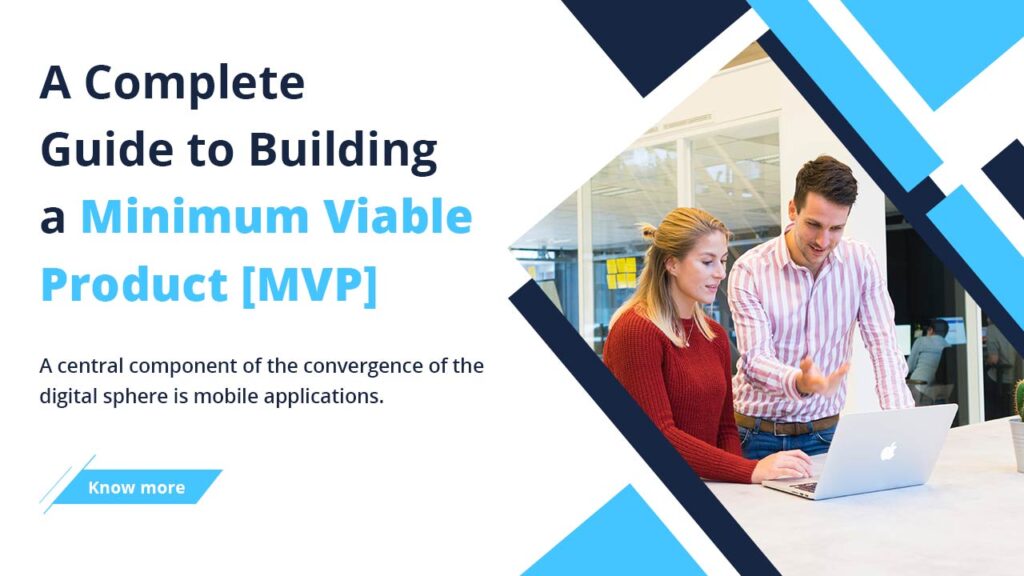A Complete Guide to Building a Minimum Viable Product [MVP]
Building a Minimum Viable Product (MVP) is crucial for startups and businesses looking to test their product ideas in the market. An MVP is a basic product version that includes only the most essential features needed to satisfy early adopters and test the market. This article will provide a complete guide to building an MVP that helps businesses validate their product ideas and iterate based on feedback.
An MVP is a product with the essential features to fulfill the needs of early customers and gather feedback for further development. It allows you to test the market with minimal investment and collect valuable data to improve your product before a full-scale launch.
Indeed, if you are reading this, you already have an app idea brewing in your head. This article will explain how to build a minimum viable product step by step.

Building an app takes time and money, so why not build an MVP to raise funds for your app? What is MVP? Let’s see.
An MVP, or minimum viable product, is a version of your app with just the bare essentials, allowing you to get it out to potential investors quickly and cheaply. It is a product with just enough features to satisfy early customers and provide feedback for future product development. Developing an MVP app allows you to show investors your app without spending too much money developing it. A great designer and a talented app developer like Delaine are the only two things you need to get started.
Table of Contents
Why an MVP?
The benefits of an MVP are that it allows startups to validate their ideas quickly and cheaply without having to build a fully-featured product. This can save time and money in the long run, allowing startups to focus on the most critical features first. An MVP also will enable startups to get feedback from users early on, which can help them make better decisions about the direction of their product.
5 steps to building a successful MVP for your business
To determine what features to include in your MVP, follow these 5 simple steps:
Identify the core features of MVP.
The first step in building an MVP is to identify the problem that your product is trying to solve. This involves conducting market research, analyzing customer feedback, and identifying a pain point your product can address.
After figuring out your target audience, you can pinpoint the core features your MVP needs to have to attract and retain early customers. These features should be the minimum functionality required to solve your target market’s pain points.
Define your target market:
It’s essential to understand who your target market is. Conduct research to identify their needs, pain points, and preferences. This will help you focus on your MVP’s most essential features.
Once you’ve identified the problem, you need to define the target audience for your MVP. This involves identifying the characteristics of your ideal customer, including demographics, psychographics, and behaviors.
Creating a prototype
A prototype is the first step in building an MVP that can raise money for your mobile app. A prototype is a working model of your app that allows you to test your app with potential investors and customers.
Creating a prototype is critical in MVP development because it allows you to validate your concept with potential investors and customers. It also allows you to identify any potential problems with your app before you start building the full version.
To create a prototype, you’ll need to wireframe your app and create a primary user interface. You can use online tools or hire a designer to help you with this step. Once you have a wireframe, you’ll need to create mockups of each screen in your app. These mockups should include all the functionality and features you want to include in your final product.
Conduct real-time user testing.
User testing lets you see how people interact with your app and identify improvement areas. Creating a prototype aims to confirm the app concept with actual users. The application is then tested with users following this process. User Testing helps you recruit real users to test your app and provides valuable feedback. As with MVP, you can collect subjective feedback and monitor the reactions.
Write the code and Test.
Once users have accepted the prototype, it is ready for coding. During this stage, MVP is tested for technical feasibility and cross-device compatibility. Here, the development team comes into the picture and starts constructing the MVP. Integration of third-party solutions and APIs takes place. Coding is the foundation for successful application development.
Having a glitziest your MVP. Although full-scale testing is unnecessary, you should account for stress and functional testing. Testing also ensures that the app works smoothly regardless of the number of features it has.
Launch and gather feedback.
As soon as testing is complete, deployment can begin. The MVP must now be made public. The app is uploaded to Google Play and App Store in the production environment.
How to market your MVP to investors
You now understand how to build a successful MVP and why it is a great tool for getting your startup off the ground quickly and efficiently. But how do you market your MVP to investors?
Here are a few tips:
- Keep it simple. Don’t try to oversell your MVP – present it as it is. Investors are looking for a product that solves a problem, so emphasize how your MVP does just that.
- Be prepared to answer tough questions. Investors will want to know why you created an MVP instead of a complete product, so be ready with data and convincing arguments.
- Have a solid plan for what’s next. An investor wants to see that you have a clear vision for where your startup is going, so lay out your plans for further development and growth.
- Be sure to highlight the team behind your MVP.
Final Words
Finally, remember that an MVP doesn’t have to be perfect – it just needs to be good enough to get the job done. With these tips in mind, you should be able to build a successful MVP on a budget without any problems. A successful MVP will surely attract millions of users if everything is done right.
Building an MVP is a crucial step in the product development process. It allows you to test the market with minimal investment, gather valuable data, and improve your product before a full-scale launch. At Delaine, we have the expertise and experience to guide you through the process and help you create a successful MVP. Contact us today to learn more about how we can help you turn your innovative ideas into reality.





